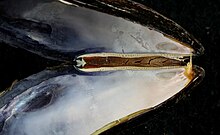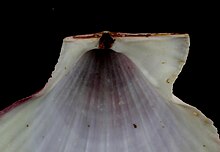


A hinge ligament is a crucial part of the anatomical structure of a bivalve shell, i.e. the shell of a bivalve mollusk. The shell of a bivalve has two valves and these are joined by the ligament at the dorsal edge of the shell. The ligament is made of a strong, flexible and elastic, fibrous, proteinaceous material which is usually pale brown, dark brown or black in color.
In life, the shell needs to be able to open a little (to allow the foot and siphons to protrude) and then close again. As well as connecting the two bivalve shells together at the hinge line, the ligament also functions as a spring which automatically opens the valves when the adductor muscle or muscles (that close the valves) relax.
